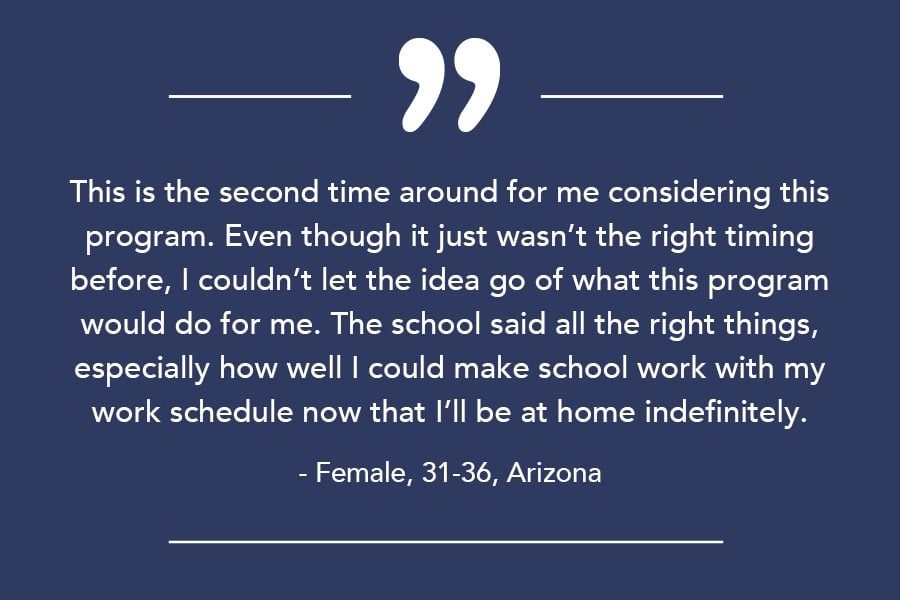
College enrollment is down in Fall of 2020 — about 4% from Fall 2019. It’s easy to predict that a global pandemic, which impacted everything from campus life to the world’s economy, would also affect enrollment numbers. But the most important learnings from 2020 enrollment trends are in the details.
Let’s start with graduate enrollment, which was up 2.7% over 2019. Although that represents a slower rate of increase compared to last year, it does suggest that some students are still dedicated to attaining their degree, no matter the learning environment.
The truth is, the enrollment puzzle doesn’t have an answer as simple as the pandemic. To understand the enrollment trends, you have to look at each specific segment student. Take non-traditional students; college enrollment numbers for non-traditional students have been dropping consistently for a few years. What has been missing for them? How can colleges and universities reignite their interest in higher education? Let’s discuss.
Why Are Non-Traditional Learners Delaying College?
First, it’s important to understand who non-traditional students are and what role they play in college enrollment numbers. The National Center for Education Statistics defines a non-traditional student as anyone who delayed college enrollment after graduating from high school, attends college part-time, works full-time, is financially independent, or has dependents.
Put this way, it makes sense that non-traditional students have slowed their college enrollment. With so many different goals and lifestyles to consider, marketing to non-traditional students is an extremely nuanced task. Their motivations, values and decision-making factors span a vast range. But someone who doesn’t feel invited by marketing efforts won’t feel inspired to enroll, either. So, although the task may present a different set of challenges, enrolling these students is critical for higher education’s continued success.
How to Encourage Non-Traditional Learners to Stop Delaying Pursuing Education
The driver behind most people’s decision to enroll in college is to make themselves more competitive in the job market. They want to obtain new skills, knowledge or certifications that will provide a better future for themselves and their families. For non-traditional students, the main difference is what that future looks like. They have different timelines, different people affected by their decisions, and different resources to make that future happen than traditional students.
If there’s one thing the circumstances of 2020 taught all of us, it’s how to think about the future differently. Here are a few ways you can show new possibilities to non-traditional students and increase enrollments for your institution.
 For more insight on how you can tailor your institution's marketing and student experience to what today’s students seek, download our white paper here.
For more insight on how you can tailor your institution's marketing and student experience to what today’s students seek, download our white paper here.
Diversify Your Value
Non-traditional students value their continued education in different ways than traditional students. For example, our research found that 47% of non-traditional students rate distance learning as extremely effective (compared to 35% of traditional students). The transition to online classes that COVID-19 demanded did not affect non-traditional students in the same way. In fact, some might even prefer online course offerings.
But the differences don’t stop at the classroom experience. Their confidence in finding a job post-graduation is more than double that of traditional students. Non-traditional students are those who have held full-time jobs before, or have them now. The education, certificates and training they seek are not to create a future for themselves, but rather to enrich what they’ve already created.
For your marketing campaigns to connect with non-traditional students, you need to diversify the way you talk about your value.
- Add nuance and context that speaks to the different life paths of non-traditional students.
- Talk about the variety your institution offers.
- Speak to the ways in which non-traditional students may be able to customize their experience so that continued education isn’t an interruption to their life, but an addition.
One survey respondent expressed the value of the school speaking to her situation, sharing, "Even though it just wasn't the right timing before, I couldn't let the idea go of what this program would do for me. The school said all the right things, especially how well I could make school work with my work schedule now that I'll be at home indefinitely".
To stop the decline of non-traditional students’ enrollment, it’s up to the colleges, universities and institutions to diversify how they message their value. Use the variety of students, faculty and staff available to you in order to connect with potential non-traditional students.
Personalize Your Offerings
While continued education is a privilege that certainly adds to a person’s life in a multitude of ways, it isn’t a requirement. For non-traditional students, especially, the burden of the added responsibility of coursework and deadlines may outweigh their desire to earn a new degree or certificate.
In order to ensure that these students understand the value of continued education, colleges need to abandon the one-size-fits-all approach to marketing their degrees and start to personalize the messaging. Non-traditional students know that their life is more rigid than a traditional student’s life might be. If colleges don’t prove that students can mold their college experience to fit their current life, it’s likely that many potential non-traditional students won’t even consider continued education. We’re seeing the results of that now in the slow enrollment rates.
Use your marketing efforts and build entire campaigns around showing the different ways a person can reach their goals at and beyond your school. Provide tangible content to demonstrate the different paths towards a degree, especially if some of those paths can be customized and personalized around an existing life stage. Non-traditional students will enroll in the institutions that show they understand what these students’ life demands.
.jpg?width=900&name=WhitepaperBlog2_Image_3-900x600%20(1).jpg)
Highlight Your Response Efforts
Our research showed that 72% of non-traditional students found higher education’s response to the pandemic to be extremely or very effective, compared to only 62% of traditional students. Whereas many traditional students might consider delaying their continued education until the college experience returns to “normal,” non-traditional students never needed the “normal” college experience.
Some non-traditional students see the quick response as proof that their university values their time. Non-traditional students don’t have the luxury of waiting for the pandemic to be over. They needed their education to continue on the timeline they planned for.
To recruit more non-traditional students to your school, highlight your response efforts from the pandemic. Show what you learned and what you plan to do in the next 2-4 years. Many non-traditional students will appreciate that you are proactive and transparent in your communications efforts. The more reliable they see your school, the better chance you have at getting the non-traditional students to enroll.
Higher Education Marketing and Enrollment Strategies
LaneTerralever is an agency that specializes in developing higher education marketing strategies for clients, including Rio Salado College, Southern California University of Health Sciences, Universal Technical Institute, Northcentral University, and Touro University Worldwide. We often conduct primary research to understand the needs of our client’s customers so we can make the most informed marketing strategies possible.
Learn More Strategies to Solve for Drop in Enrollment
Of course, the strategies don’t stop there. With such a large section of the population, there’s a lot to learn about and from non-traditional students interested in continued education. Get access to the research from our team, plus the insights necessary to build better marketing campaigns by filling out the form here. We’ll deliver our newest white paper, The Pandemic’s Impact on Higher Education Marketing in 2020 and Beyond, directly to your inbox.



